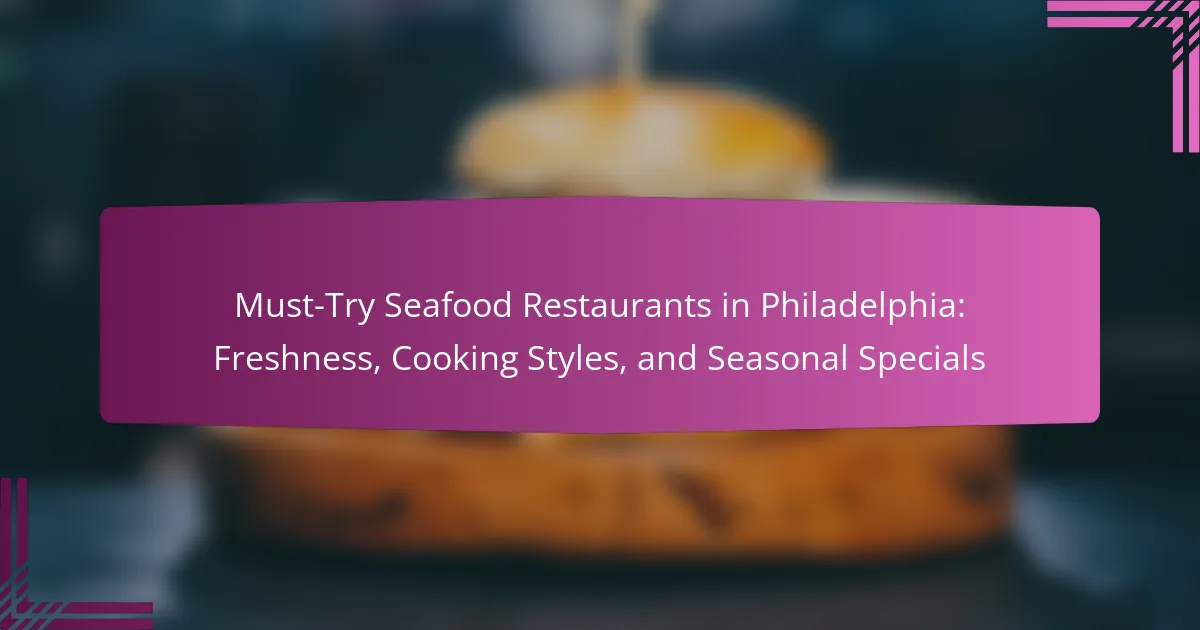
What are the Must-Try Seafood Restaurants in Philadelphia?
Oyster House, located on Sansom Street, is known for its fresh oysters and seafood dishes. It has received positive reviews for its raw bar and classic New England clam chowder. Another must-try is The Fishery in the city’s bustling Rittenhouse area. This restaurant specializes in sustainable seafood and offers a seasonal menu. The menu features a variety of fish sourced from local fisheries. Additionally, the iconic Luke’s Lobster provides a taste of Maine with its lobster rolls and crab bisque. The restaurant emphasizes quality ingredients and a casual dining experience. Lastly, the popular Legal Sea Foods offers a diverse menu that includes clam chowder and grilled fish. It is recognized for its commitment to freshness and quality.
Why is Philadelphia known for its seafood dining?
Philadelphia is known for its seafood dining due to its proximity to the Atlantic Ocean. This location provides access to fresh seafood, including fish, shellfish, and crabs. The city has a rich maritime history that influences its culinary scene. Many local restaurants feature traditional dishes like crab cakes and clam chowder. The Reading Terminal Market and other venues showcase a variety of seafood options. Philadelphia hosts seafood festivals that celebrate local flavors. Additionally, the city’s diverse population contributes to a wide range of cooking styles. The combination of freshness and cultural influences makes Philadelphia a notable seafood dining destination.
What historical factors contribute to Philadelphia’s seafood culture?
Philadelphia’s seafood culture is shaped by its historical proximity to the Atlantic Ocean and major rivers. The city has been a significant port since the colonial era, facilitating trade and access to fresh seafood. This access allowed diverse seafood dishes to develop, influenced by various immigrant communities. The arrival of Irish, Italian, and African American populations brought unique cooking styles and recipes. Additionally, the establishment of fish markets in the 18th century created a foundation for local seafood consumption. The city’s culinary scene has continued to evolve, incorporating modern techniques while honoring traditional flavors. These historical factors collectively contribute to Philadelphia’s rich seafood culture.
How does the city’s location influence its seafood offerings?
Philadelphia’s location along the Atlantic coast significantly influences its seafood offerings. Proximity to the ocean provides access to a diverse range of fresh seafood. The Delaware River also contributes to local fishing opportunities. Seasonal variations in catch affect the availability of specific types of seafood. For instance, summer months bring in more varieties like flounder and rockfish. The city’s location allows for quick transportation of seafood to local restaurants. This ensures freshness and quality in dishes served. Local seafood markets thrive due to the city’s strategic position.
What are the key attributes of top seafood restaurants in Philadelphia?
Top seafood restaurants in Philadelphia are known for their freshness, diverse cooking styles, and seasonal specials. Freshness is critical, with many establishments sourcing seafood daily from local markets. Cooking styles vary, offering traditional dishes and innovative preparations. Seasonal specials highlight the best seafood available at different times of the year. Many top restaurants also emphasize sustainability in their sourcing practices. Customer service plays a vital role in enhancing the dining experience. Ambiance and decor contribute to the overall appeal, making dining enjoyable. Lastly, positive reviews and ratings reflect the quality and reputation of these seafood establishments.
How do freshness and quality impact the dining experience?
Freshness and quality significantly enhance the dining experience. Fresh ingredients lead to better flavors and textures. High-quality seafood, for instance, maintains its natural taste and nutritional value. Studies show that diners are more satisfied when food is fresh. A survey by the National Restaurant Association found that 70% of consumers prioritize freshness in their dining choices. Quality also influences the perception of value. Diners associate high-quality meals with better overall experiences. Restaurants that emphasize freshness and quality often receive higher ratings and repeat customers.
What cooking styles are prevalent among these restaurants?
The prevalent cooking styles among seafood restaurants in Philadelphia include grilling, frying, and steaming. Grilling enhances the natural flavors of seafood, often using marinades for added taste. Frying is popular for its crispy texture, commonly applied to fish and shellfish. Steaming is favored for its health benefits, preserving nutrients and moisture. These cooking techniques reflect the region’s culinary traditions and focus on fresh, high-quality ingredients. Many restaurants also incorporate seasonal specials that highlight local catches, further diversifying their cooking styles.

What are the different cooking styles found in Philadelphia’s seafood restaurants?
Philadelphia’s seafood restaurants feature various cooking styles. Common styles include frying, grilling, steaming, and broiling. Fried seafood is popular, often featuring shrimp and fish. Grilled dishes showcase fresh catch with seasonings. Steaming preserves the natural flavors of shellfish like clams and mussels. Broiling is used for fish, providing a crispy exterior. Each style highlights the seafood’s freshness and quality. These cooking methods reflect the city’s culinary diversity and seafood heritage.
How do various cooking techniques enhance seafood flavors?
Various cooking techniques enhance seafood flavors by altering texture, moisture, and taste profiles. Grilling imparts a smoky flavor while caramelizing the surface. Steaming retains moisture and preserves delicate flavors. Searing creates a crispy exterior, enhancing the overall taste experience. Poaching gently cooks seafood, allowing natural flavors to shine through. Baking can intensify flavors through the use of herbs and spices. Each technique brings out unique attributes of the seafood, making it more enjoyable. For example, studies show that grilling can increase flavor compounds in fish, making it more appealing to consumers.
What are the most popular cooking styles used in these restaurants?
The most popular cooking styles used in seafood restaurants in Philadelphia include grilling, frying, and steaming. Grilling enhances the natural flavors of seafood while adding a smoky taste. Frying provides a crispy texture, often used for dishes like fish and chips. Steaming retains moisture and is a healthier option for cooking fish. Other notable styles are baking and broiling, which also highlight the freshness of the seafood. These methods are commonly employed to prepare a variety of dishes, showcasing local ingredients and culinary traditions.
How does each cooking style affect the texture and taste of seafood dishes?
Cooking styles significantly influence the texture and taste of seafood dishes. Grilling imparts a smoky flavor and creates a firm, charred exterior. Baking retains moisture, resulting in a tender texture and subtle flavors. Frying produces a crispy exterior while sealing in juices, enhancing the overall taste. Steaming preserves the seafood’s natural flavor and moisture, yielding a delicate texture. Sautéing allows for quick cooking, enhancing flavors through browning while maintaining tenderness. Poaching gently cooks seafood, resulting in a soft texture and mild taste. Each style uniquely impacts the sensory experience of the dish, highlighting different attributes of the seafood.
What role do seasonal specials play in seafood dining?
Seasonal specials play a significant role in seafood dining by enhancing menu variety and freshness. These specials often feature fish and shellfish that are at their peak during specific times of the year. For example, certain species like soft-shell crabs are only available in spring. This availability ensures that diners experience the best flavors and textures. Seasonal specials also promote sustainability by encouraging the consumption of fish that are abundant and in season. Research has shown that dining on seasonal seafood can support local fisheries and reduce the carbon footprint associated with transportation. Overall, seasonal specials enrich the dining experience while aligning with sustainable practices.
How do seasonal ingredients influence menu offerings?
Seasonal ingredients significantly influence menu offerings by dictating the availability and freshness of dishes. Restaurants often design their menus around what is currently in season. This approach ensures that the ingredients used are at their peak flavor and nutritional value. For example, seafood restaurants may feature local catches that are abundant during specific times of the year. This not only enhances taste but also supports sustainable fishing practices. Seasonal menus can attract customers seeking unique and fresh dining experiences. Additionally, changing menus with the seasons encourages culinary creativity among chefs. This practice has been shown to increase customer satisfaction and repeat visits.
What are some examples of popular seasonal seafood dishes in Philadelphia?
Popular seasonal seafood dishes in Philadelphia include soft shell crabs, which are typically available in the spring. Another dish is the Jersey flounder, often featured during the summer months. Oysters are also a staple, especially during the colder months, with many restaurants offering them fresh from local waters. Additionally, clam chowder is a favored winter dish that showcases local clams. These dishes reflect the region’s seafood availability and culinary traditions.

What should you know before visiting seafood restaurants in Philadelphia?
Before visiting seafood restaurants in Philadelphia, you should be aware of the freshness of the seafood. Philadelphia is located near the Atlantic Ocean, providing access to fresh catches. Many restaurants source their seafood daily from local markets. Seasonal specials are common, highlighting the best available seafood. Popular cooking styles include grilling, frying, and steaming. You may also want to check for sustainability practices. Many establishments prioritize sustainable seafood options. Reservations are recommended for popular spots, especially during peak dining hours. Always check reviews to find the best dining experience.
What are the best practices for ordering seafood?
Order seafood from reputable sources to ensure freshness and quality. Look for establishments that prioritize sustainable fishing practices. Check for the seafood’s country of origin to assess its quality. Ask about the catch date to confirm freshness. Observe the appearance and smell of seafood before ordering; it should look vibrant and smell like the ocean. Request recommendations from staff to choose the best dishes available. Be mindful of seasonal seafood options, as they are often fresher and more flavorful. Finally, inquire about cooking methods to ensure the dish meets your preferences.
How can you ensure you’re choosing the freshest options?
To ensure you’re choosing the freshest seafood options, look for restaurants that source their fish daily. Fresh seafood should have a mild, ocean-like smell, not a strong fishy odor. Check for clear, bright eyes and shiny skin on whole fish. Firm flesh that bounces back when pressed is a sign of freshness. Additionally, inquire about the restaurant’s sourcing practices. Restaurants that provide information about their suppliers often prioritize quality. Seasonal specials can indicate availability of fresh, local catches. According to the FDA, seafood should be consumed within 24 hours of being caught for optimal freshness.
What tips can enhance your overall seafood dining experience?
To enhance your overall seafood dining experience, focus on selecting fresh seafood. Freshness ensures better taste and texture. Look for seafood that has a clean, ocean-like smell. Avoid fish that smells overly fishy or has discolored flesh. Pair your seafood with complementary sides and sauces to enhance flavors. For example, citrus-based sauces can brighten the taste of fish. Consider the cooking method; grilled or steamed seafood often retains more flavor than fried options. Choose restaurants known for sustainable sourcing to ensure quality and ethical practices. Research shows that diners prefer establishments with transparent sourcing practices, leading to a better dining experience.
What are the must-try dishes at Philadelphia seafood restaurants?
The must-try dishes at Philadelphia seafood restaurants include the classic Philadelphia-style crab cakes. These crab cakes are known for their rich flavor and minimal filler. Another popular dish is the shrimp and grits, which offers a Southern twist with local ingredients. Oysters on the half shell are a staple, showcasing the region’s fresh seafood. Additionally, the clam chowder is a comforting choice, often made with local clams and cream. Lobster rolls are also highly recommended, served with fresh lobster meat in a buttery bun. Finally, fish tacos are a trendy option, featuring grilled or fried fish with zesty toppings.
Which signature dishes should you not miss?
The signature dishes you should not miss include the crab cakes, clam chowder, and lobster rolls. Crab cakes are known for their high-quality lump crab meat and flavorful seasonings. Clam chowder is a creamy soup that features fresh clams and herbs. Lobster rolls are served in a buttery roll, showcasing succulent lobster meat. These dishes represent the best of Philadelphia’s seafood offerings. They are highly recommended by local food critics and seafood enthusiasts. Each dish highlights the freshness of ingredients sourced from the region.
How do these dishes reflect the local seafood scene?
These dishes reflect the local seafood scene by showcasing the region’s abundant marine resources. Philadelphia’s proximity to the Atlantic Ocean provides access to fresh fish and shellfish. Local restaurants incorporate seasonal catches into their menus, emphasizing freshness and sustainability. Dishes often feature iconic ingredients like blue crabs and flounder, highlighting regional specialties. The cooking styles vary, from traditional preparations to innovative culinary techniques. This diversity in preparation reflects the cultural influences present in Philadelphia. Overall, the seafood offerings mirror the local fishing practices and community preferences.
The main entity of the article is seafood restaurants in Philadelphia. The article provides an overview of must-try seafood dining options in the city, highlighting renowned establishments such as Oyster House, The Fishery, Luke’s Lobster, and Legal Sea Foods. It discusses Philadelphia’s seafood culture, influenced by its coastal location and historical factors, and emphasizes the importance of freshness, diverse cooking styles, and seasonal specials in enhancing the dining experience. Additionally, the article outlines key attributes of top seafood restaurants, popular cooking techniques, and signature dishes that reflect the local seafood scene.


